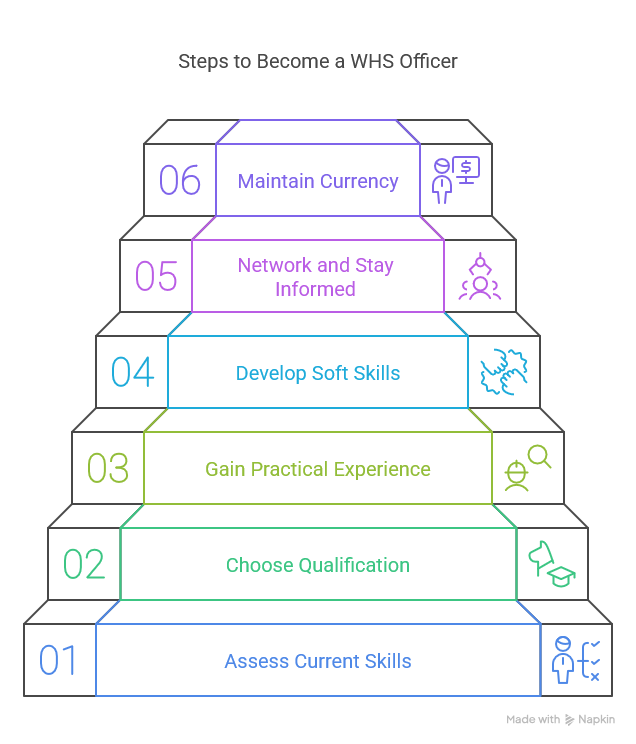One of the most pressing questions for anyone considering a career in WHS is: "How much does a health and safety officer earn in Australia?" Compensation often reflects both the scope of responsibilities and the level of risk involved. As underscored in our article, "Work Health and Safety Qualifications: Which Is the Right One for Your Career Path?", obtaining formal credentials like the BSB41419 Certificate IV in Work Health and Safety or the BSB51319 Diploma can significantly boost your earning potential. In this expanded piece, we'll delve into salary averages, address regional and industry nuances, and clarify how moving up the qualification ladder can lead to improved financial outcomes.

Salary Ranges and Influencing Factors
According to aggregated job market data, entry-level WHS officers in Australia can earn anywhere between AUD $60,000 to 80,000 annually. This band typically covers those with a Certificate IV or some on-the-job safety experience. Salaries often rise as you accumulate hands-on expertise or complete advanced study—like a Diploma. WHS advisors or managers can realistically command AUD $90,000 to 120,000, while highly specialised or senior roles sometimes push beyond AUD $120,000.
Primary factors influencing these figures include:
- Qualification Level: A Diploma or advanced credential usually draws higher pay than a Certificate IV alone, especially in industries with stringent compliance requirements.
- Experience and Track Record: Demonstrated success in reducing incident rates, leading audits, or passing major compliance milestones can sway salary negotiations.
- Industry Risk Profile: High-risk sectors—like construction, mining, oil and gas—tend to offer greater compensation due to the complexity of hazards.
- Location and Role Type: Salaries in remote areas can be higher, particularly if the employer covers living or travel expenses. Likewise, FIFO (fly-in, fly-out) roles may include additional perks.
High-Paying Industries
Certain Australian sectors are synonymous with top-tier WHS salaries:
Mining and Resources
Remote mines require robust safety oversight, and the complexity of tasks often means employers pay a premium for skilled personnel.
Oil and Gas
Offshore rigs and complex processing facilities create specialised roles demanding strong compliance measures and advanced safety planning.
Major Construction Projects
Infrastructure developments, rail expansions, or large-scale commercial builds require comprehensive risk management, making senior WHS positions lucrative.
Heavy Manufacturing and Industrial
Plants dealing with heavy machinery or hazardous materials offer competitive compensation to those with advanced WHS qualifications.
In these settings, the presence of sophisticated machinery, potential chemical exposures, and stringent timelines amplify the role of a WHS officer or manager. Consequently, professionals who hold either a Diploma of WHS or years of proven experience (often both) can be well-positioned for six-figure incomes.
Geographical Variations
Australia's diverse geographies and job markets lead to noticeable pay differences:
- Capital Cities (Sydney, Melbourne, Brisbane, Perth): Higher costs of living can correlate with slightly inflated WHS salaries. Corporate roles and larger businesses headquartered in cities may also pay more to secure top talent.
- Regional and Remote Areas: Many remote roles pay additional allowances for living costs, isolation, or travel, pushing total compensation higher. Mining towns, for instance, often offer package deals that include housing or FIFO arrangements with strong salaries.
- State Differences: States with high volumes of resource extraction or significant construction booms—like Western Australia or Queensland—often see elevated average salaries for WHS practitioners.
Advancing Your Career and Pay
Securing a higher salary usually involves a blend of qualifications, experience, and a track record of tangible results. If you begin as a safety coordinator with a Certificate IV, you might see incremental raises as you:
- Complete a BSB51319 Diploma in Work Health and Safety.
- Lead or significantly contribute to successful WHS audits or improvements.
- Build specialised expertise (e.g., incident investigation, ergonomics, hazardous substances).
- Move into roles with broader managerial oversight, such as WHS Manager or Compliance Director.
In many organisations, especially larger companies, pay grades correspond to these escalation points. Some professionals parlay their leadership roles into consultancy work, setting their own rates to advise multiple clients.
Why Qualifications Matter
Australian businesses increasingly look for formal credentials as a shorthand for competence and credibility. With legislation constantly evolving, a person who has completed a structured course stands out as someone informed about current practices, even if they must continue learning throughout their career. Possessing only on-the-job experience without a recognised qualification can sometimes limit your upward mobility, especially in more regulated or corporate-driven sectors.
Beyond Salary
While pay is important, many WHS professionals find inherent reward in creating safer, healthier workplaces. The role provides a clear social contribution, which can be deeply fulfilling, especially when employees credit effective WHS policies for reducing injuries or improving work conditions. The Australian Institute of Health & Safety and other professional bodies often champion this ethos, encouraging members to see themselves as advocates for employee well-being, not just compliance enforcers.
In Australia, the salary for a health and safety officer can range widely, influenced by qualifications, industry demands, geographical factors, and proven performance. Earning a BSB41419 Certificate IV or a BSB51319 Diploma helps you stand out, allowing for swifter ascension in the ranks and greater earning potential.
As you accumulate real-world successes—reducing incident rates or spearheading critical compliance initiatives—your value in the marketplace increases, often aligning with a higher salary band.